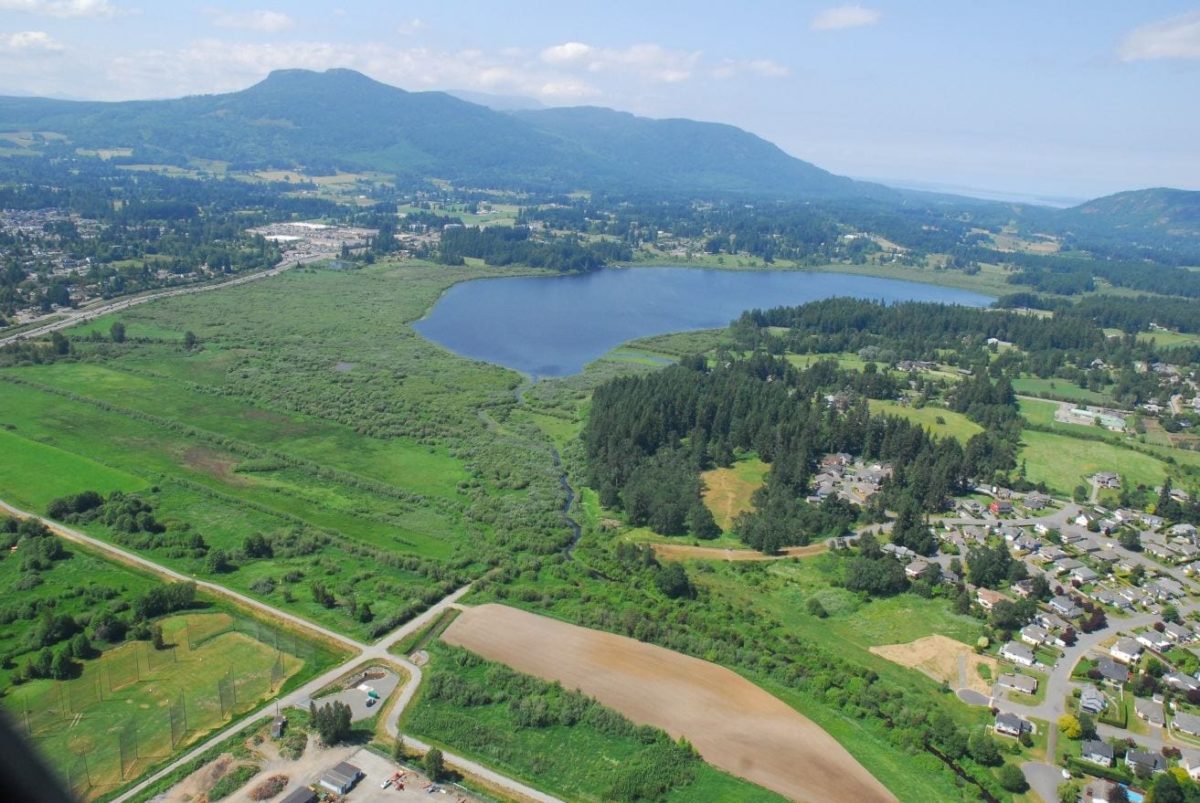
A unique wetland habitat and rare Garry Oak ecosystem in the Cowichan Valley make up B.C.’s newest wildlife management area.
The Somenos wetlands, just north of Duncan, are a prime wildlife viewing site. Over 200 bird species have been observed, including the second-largest population of over-wintering trumpeter swans on Vancouver Island and year-round habitat for great blue herons. The area is internationally recognized for its significant fish and wildlife habitat.
“Wildlife management areas help to meet government’s mandate to sustainably manage B.C.’s ecosystems, rivers and lakes, as well as improving wildlife management and habitat conservation,” said Doug Donaldson, Minister of Forests, Lands, Natural Resource Operations and Rural Development. “We want to protect these kinds of areas for generations to come.”
The S’amunu wildlife management area (WMA) contains about 155 hectares of highly productive lake, seasonally flooded wetlands and riparian habitat, as well as significant cultural features. The WMA lies in the heart of the Cowichan Tribes (Mustimuhw) traditional territory. Somenos Creek was a major travel corridor for the Cowichan people from their traditional village site adjacent to Somenos Lake to the Cowichan River. The traditional local Hul’qumi’num name for this area is S’amunu.

“We are happy to see this work take place and, going forward, work together to restore and preserve the land back to its natural state,” said Chief William Seymour of Cowichan Tribes. “It is important for us to keep its ecological value intact. It will be a great gathering space where the community can come and be educated on the history of this area, including our villages Kwa’mutsun and S’amunu that used to inhabit this land, as well as learn about the vegetation and wildlife that thrive at Somenos Marsh.”
Much of the land within the WMA (142 hectares) was originally acquired for conservation purposes by The Nature Trust of British Columbia and Ducks Unlimited Canada — some with support from the federal and provincial governments.
The Somenos Marsh Wildlife Society has developed elevated boardwalk trails, nature interpretive and information signs, and viewpoints to provide year-round wildlife viewing opportunities in the area.
The WMA is part of a network of conservation lands that includes lands owned by the Municipality of North Cowichan, the B.C. Forest Discovery Museum and additional land conserved by The Nature Trust of British Columbia.
Quotes:
Jasper Lament, CEO, The Nature Trust of British Columbia —
“This is a wonderful day for conservation in our province. We are proud to be a partner in the designation of the S’amunu wildlife management area. We’ve been working since 1976 to secure key land parcels to ensure the many habitats comprising the Somenos conservation lands are protected in perpetuity. The new S’amunu WMA demonstrates what is possible when conservation partners work together through programs such as the Crown Land Securement Partner Program.”
Dan Buffett, manager of provincial operations – B.C., Ducks Unlimited Canada —
“The wetlands of the Cowichan Valley provide critical wildlife habitat to a significant proportion of Pacific Flyway migratory birds, and this designation now recognizes the importance of greater protection of migratory bird habitat at Somenos. Thousands of waterfowl seek food and refuge, especially during the fall to spring seasons when flooding persists to expand the Somenos wetland complex. Ducks Unlimited was pleased to be able to acquire the Somenos lake bed earlier this year, and by leasing our property to the ministry, we are able to add to the WMA. “
Paul Fletcher, president, Somenos Marsh Wildlife Society —
“The Somenos Marsh Wildlife Society is very excited and pleased that, after 30 years of starting the process, the S’amunu Wildlife Management Area is to be established on provincial lands within the Somenos Marsh Conservation Area. As long time stewards of the area, we are committed to continuing to work with all of the partners to ensure that the tremendous ecological and cultural values of Somenos are sustained into the future.”
Quick Facts:
A WMA designation helps to promote collaboration and shared stewardship to conserve fish and wildlife habitat, while respecting other land uses. More specifically, a WMA designation provides:
- a management plan for the area that encourages conservation and shared stewardship
- a forum to engage local First Nations and stakeholders on conservation and management issues
- additional legal tools for the ministry to consider in conservation management
- partnership opportunities for research, education and management activities
With the S’amunu WMA designation, there are now a total of 31 wildlife management areas in B.C., ranging in size from the 17-hectare Coquitlam River WMA to the 122,500-hectare Todagin WMA in northwestern B.C. Together, these sites encompass over 246,500 hectares.
